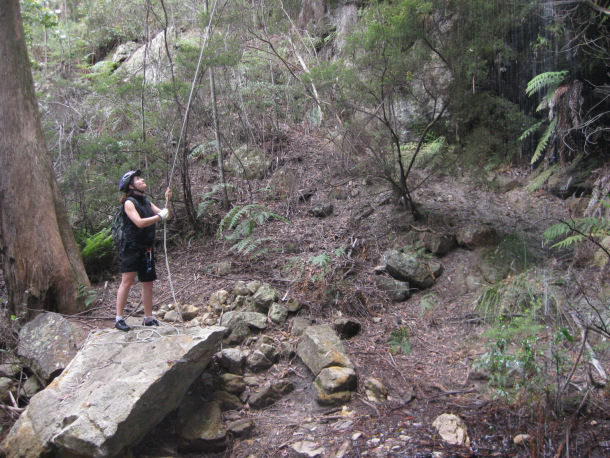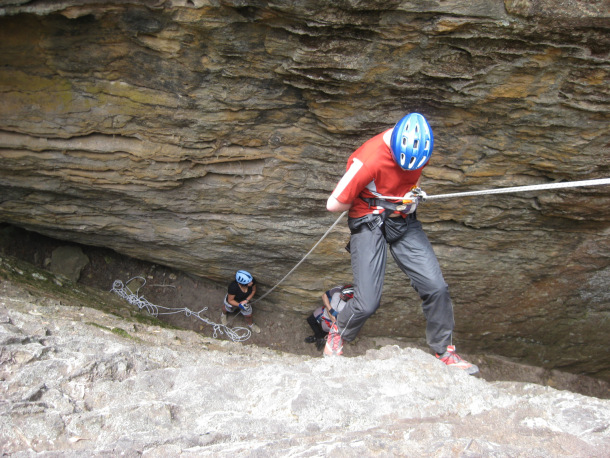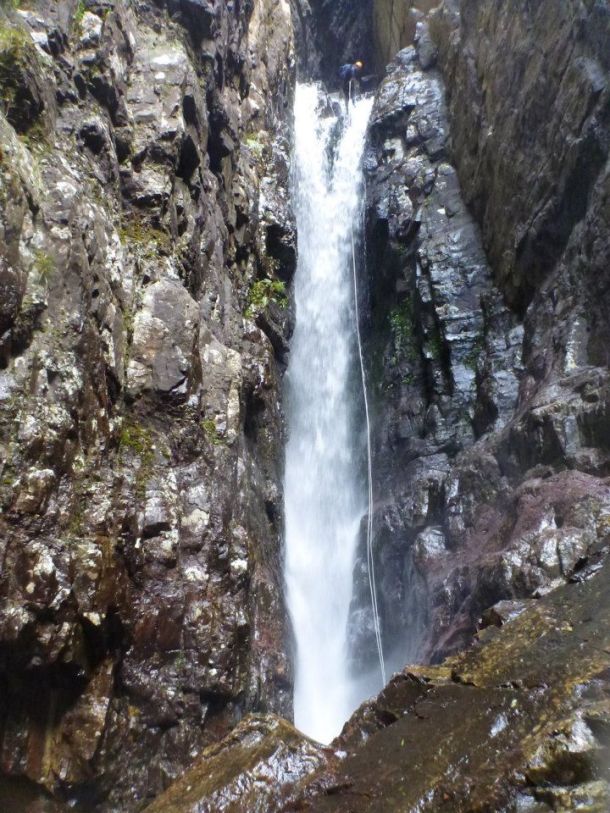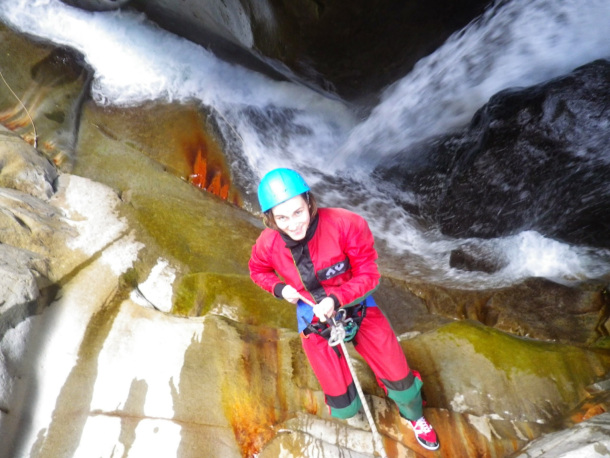We all know that canyoning is a potentially dangerous activity and not a year goes by without a life being claimed somewhere. Nevertheless, we still love being out in the bush, and we love being in the canyons, and we don’t want to miss all the adventures we experience out there. Since we are aware of the dangers, we have specific routines and protocols that we follow during our activities, in particular for the most technical part of canyoning, abseiling.
But as much as we all agree that abseiling has to be done in a safe way, there is also a lot of disagreement on what exactly is the safest way overall. Single rope, double rope, anchor setup, call signs, top belay, bottom belay, self-belay, fall arrest device and the type of descender are just a few keywords that can easily get a heated conversation started, frequently involving sentences along the lines of “where I come from, everyone always does …”. A discussion I get dragged into regularly is that of bottom belaying – especially since I often make it a requirement that people coming on my trips are able and feeling comfortable to abseil without bottom-belay.
To understand why many people believe their way is the only safe way, we have to look back at how we teach beginners. When we teach a beginner how to abseil, we are usually quite conscious about the amount of information a person can grasp and process in the short time available before we send them down the first pitch. While there are many different ways of abseiling with all its pros, cons and special cases, we have to limit our instructions to a clear protocol that is suitable for the beginner. The protocol is designed to be easy to follow and result in a relatively safe descend. We teach them to use a particular descender. We tell them that the anchor has to have a certain knot. We tell them how to hold their hand and what to do with the spare hand. We tell them what to shout out before and after the descend. And we usually tell them to always bottom belay each other, too.
This beginner protocol then becomes ingrained into people’s routine and is hardly ever questioned. After all, it is what people learned and how they feel safe. However, this protocol does by no means constitute the only safe way to abseil and sometimes even produces odd artefacts. This becomes most visible when listening to the call signs. A typical routine might be to shout “on rope” to tell the belayer to get ready and respond with “on belay” which is then followed up by “abseiling” when the descent begins. I’ve often seen people do the call signs when being the first one to descend. The entire group is standing right next to the abseiler, and there is no one at the bottom to belay. Nevertheless, the abseiler shouts loudly “on rope” and “abseiling” because that is the protocol that was enforced when he first learned to abseil. Clearly, not doing the call signs wouldn’t make the abseil any less safe. On the other hand, they aren’t doing any harm either, so there is no need to start a discussion and tell people off.
It is also worth noting that there is more than one possible and safe beginner protocol, and the one that is used is sometimes based on recent incidents or research, but more often it is a result of the current fashion or the preferences of the instructor. While the differences are often nuances, there can be quite severe differences in what is considered best practice. I know of an example from the rock climbing community. The teaching protocol of a large German mountaineering organisation explained how to hold the rope when belaying another climber and what not to do. A few years later, the protocol was changed, and the “correct” way was one of the previously forbidden moves. The explanation for the seeming contradiction was, that both ways, executed correctly, are safe. The decision was merely based on which method was faster to learn without making mistakes. Thus, if one was already well practised using the old technique, there was no need to change.
Bottom Belay
While the beginner protocol is certainly necessary and appropriate for teaching beginners, once we gather more skills, at some stage, it is worthwhile stepping back and trying to understand the reasons for why we do things a certain way, the downsides of the method and whether there might be a better way of doing it. Here I’d like to discuss the technique of bottom-belaying and why my enthusiasm for it is limited.
Bottom-belay, also called “fireman’s belay”, is a method where a person at the bottom of the pitch holds the rope. If the abseiler loses control of the descent, the belayer can pull on the rope which increases the friction in the descender of the abseiler and stops or at least slows down the person’s fall. For it to work, the belayer has to react quickly and firmly which means the rope should have little or no slack, the hands should be in a position to pull quickly, and the belayer has to pay attention to what the abseiler is doing.

Since the belayer pulls on the rope that is already there, the technique does not require any additional gear, making it a very lightweight method. This is in contrast to top-belaying where an extra belay rope and belay device is needed. Furthermore, bottom-belaying requires virtually no setup. All that is necessary is the person at the top calling out “on rope” and the belayer holding onto the rope and confirming with “on belay” and everything is good to go. Thus, there is as good as no time penalty for using the technique. Again, an advantage compared to top-belaying where the belay rope needs to be reset for each abseiler in a party.
Another advantage is that bottom-belaying does not require any additional skills on the abseiler’s part (apart from the call signs). This is in contrast to techniques such as autoblock which can be challenging for a beginner. Also, it is easy to learn how to be a belayer which contrasts the comparably complicated setup and handling of a top belay.
Using this line of thought, bottom-belay provides added safety at no additional cost in the form of gear, time and training needed. A perfect technique. A technique we should always use. A technique we should not only use for beginners, but for everyone at every abseil.
Limitations of bottom belaying
On closer look, however, there are a number of limitations to the technique. The most obvious being, that the first person going down can’t be belayed this way, simply because there is no one at the bottom of the pitch to do so. Thus, the first person either has to take the extra risk (analogous to the common “Last Man At Risk” paradigm) or has to use other means of belaying the descent.
Another fundamental issue with bottom-belaying is its catastrophic failure mode: if the belayer is unable to tighten the rope fast enough for whatever reason, the abseiler hits the ground at full speed. This contrasts the failure mode of other techniques. In a top-belay setup, if the belayer doesn’t dispense the rope fast enough, the abseil is slowed down. While this can be annoying, it is usually no safety concern. Similarly, autoblocks and other self-belay devices tend to lock when mishandled. Again, more a nuisance than a safety issue, especially here in Australia where drowning in swift water is rarely a concern.
The significance of the catastrophic failure mode becomes obvious when the belayer is unable to see the abseiler. Without a direct line of sight, there is no way of detecting fast enough, whether the abseiler has lost control of his descent. This is different to top-belaying, where the belayer controls the speed of the belay rope at all times and can maintain safety without any visibility.
To be able to stop a falling abseiler, a significant amount of force on the rope is necessary. Thus, the belayer needs a stable position on solid ground – a condition that is not always given in a canyon, especially if there is a pool at the bottom of the abseil. Furthermore, the belayer has to pull enough rope to compensate for rope stretch. In fact, if the pitch gets too long, the bottom belay can become ineffective altogether.

In my experience, people often don’t appreciate the limitations of bottom-belaying. They shout “on rope” and if they hear an “on belay” back, they feel safe. Only few people stop and think whether there is a clear line of sight.
However, despite all these limitations, people have been saved thanks to a working bottom-belay. Thus, with all the arguments above, it is still a valid point to say that bottom belay should be attempted where possible. It may not work all the time, but the times it does, it provides added safety. And as long a bottom belaying comes without risks and costs, it would be similar to the call signs shouted out by the first person going down: useless, but harmless.
Dangers of bottom belaying
Unfortunately, there are also risks involved with bottom-belaying.
It is a common mistake that belayers, especially when they are beginners, hold the rope tightly in their hand instead of just loosely holding onto the rope in a way that allows the rope to move as needed. The result is an awkward feeling for the abseiler of not being in control of the rope. While this is hardly a safety concern and can be solved quickly by yelling at the belayer, there is a similar and less predictable issue when the belayer pulls the rope prematurely. Especially when the belayer is not standing directly below the abseiler, a sudden pull on the rope yanks the belay hand to the side, impacting the control the abseiler has over his descent. During a slippery or otherwise delicate abseil, the abseiler could loose balance and, in unlucky circumstances, it might even be possible to pull the rope out of the belay hand. Thus, the abseiler lost control of the abseil and is now at risk of the bottom-belay failing only because of bottom-belay being there in the first place.
But the abseiler is not the only person at risk. There is also a significant risk for the belayer of getting hit by fallen rocks or, if belaying fails, by the abseiler himself. Almost everywhere were we abseil, there is at least some potential for loose rocks. We often approach the top of a pitch and already send down the first few stones while getting ready to abseil. Particularly in canyons, the area below is often narrow, and there is no safe place to stand for the belayer. But also on seemingly clean abseils rock fall is possible.
Not too long ago I lead a trip down Castle Head. I had my party bottom-belay most of the pitches and went last myself. One of the abseils is a 40m drop off a clean, rocky nose. As I went down last, I pushed myself off the wall above an overhang, intending to “jump” across it. I slightly misjudged the size of the overhang and swung into the cave. I only noticed too late that my feet were going to a big piece of loose rock that was lying on a little outcrop. The rock got dislodged, fell down, hit the wall once where it split into about half a dozen pieces and rained onto the rest of my party who gathered around the bottom-belayer at the end of the pitch. Only due to a miracle, no one got hit by the rock pieces while a big piece crashed down mere centimetres next to one woman’s head.
Not only rock fall puts the belayer at risk. Most canyons have water in them, and most abseils are effectively waterfalls. Even if the waterfalls aren’t flowing, there are often cold pools at the bottom. Thus, a potential bottom-belayer is forced to stand in cold creek water and possibly has to brave a constant stream of water from above. Even on a warm day, it doesn’t take much to get cold in these circumstances. And even if it doesn’t lead to hypothermia, being cold makes a person clumsy and exhausted, both of which increase the risk of slipping, falling or making other mistakes that easily result in injury.
Taking into account rock fall and exposure, bottom-belay suddenly comes with a significant risk – not for the abseiler, but for the belayer. Thus, the previous argument, that bottom-belay is unreliable but harmless is no longer valid. To make things worse, the risk has to be taken not by the person abseiling, but by another member of the party who does not benefit from it. This is in contrast to, for example, autoblock techniques where the associated hassles and dangers are imposed on the beneficiary of the technique, the abseiler. Effectively, when using bottom-belay, the abseiler is asking someone else to take over some of the risks for him.
It is this transfer of risk that makes me reluctant to use the bottom-belay technique. More so since it is already a technique with many limitations. Furthermore, the belay is beyond the control and scrutiny of the abseiler. When using top-belay, the abseiler can at least check that everything is in order at the beginning, and during the abseil, one can check whether the rope is getting dispensed at an appropriate rate. Also when using an autoblock setup, the system is attached to the harness of the abseiler who has full control over every aspect of the system. But with bottom-belay, the abseiler only hears an “on belay” and has to trust it.
Conversely, the belayer has to trust the abseiler not to dislodge rocks and debris since he is often unable to get to a safe place while maintaining a line of sight and being close enough to belay effectively.
In many, if not most situations, I’d feel uncomfortable asking another person to risk his well-being in order to reduce the risk for me – especially when I can’t be certain whether a bottom belay would be effective. Without belay, at least it is me who is taking the risk for my mistakes.
Alternative techniques
Luckily for us, bottom-belay is not the only way to belay an abseil. I already mentioned the most common two alternatives: top-belay and autoblock.
Top-belay
Top-belaying has the advantage, that it is very safe in most situations because it offers true redundancy for all components of the abseil. For this reason, commercial operators in Australia usually insist on top belaying their clients. The downside is, that it is very slow and requires extra gear to be carried. Being slow is not only a nuisance but can also be a liability. When stopping in dark, wet canyons, people get cold and exhausted and potentially even hypothermic. Furthermore, being slow increases the risk of becoming benighted, and once a trip reaches a certain length and amount of abseils, the trip may simply become infeasible to tackle in a single day. Thus, as safe as top-belaying is, it is simply not a viable option for all but short trips.
Autoblock
Autoblock is a family of techniques where the abseil is set up in a way that it automatically stops when the abseiler loses control. One method is, to tie a very short prussic loop onto the rope below the descender and attach it to the leg loop of the harness. The prussic must then be guided along the rope with one hand while descending. As soon as the prussic isn’t actively pushed downwards, it locks and thus stops the descent.
Using an autoblock has a fundamental difference compared the other modes belaying: it makes the abseiler self-sufficient. No other person is in charge of the belay. Instead, the abseiler has full control over all aspects of the technique.
With a bit of practice, the autoblock can be set up very quickly which means, the time penalty for using it is small for an experienced group.
However, there are risks associated with autoblocks as well. Most notably, one always has to be prepared for the autoblock to get stuck to the point that it is impossible to move it without unloading the rope. If this happens, the abseiler either needs to prusik up the rope a few centimetres using normal prussic loops or the autoblock needs to be cut. This requires the abseiler to carry prusiks and a knife and be proficient in using them, potentially with only one hand. While this kind of skills can be expected from an experienced abseiler, it takes a while until a beginner has reached such a skill-level.
While autoblock isn’t the saviour that can be used in any situation, in my experience, it is suitable for all situations where bottom-belay can be used effectively and safely. Thus, if the members of my party are sufficiently skilled for using autoblocks, I would always prefer using autoblocks over bottom-belays.
Belaying and water
While most abseils in the Blue Mountains are dry abseils, occasionally we have to deal with flowing water, too. As soon as we need to abseil in a flowing waterfall, there are a whole lot of extra considerations. Most notably, getting stuck mid abseil can get dangerous very quickly due to the risk of drowning, water pressure impeding movements and control, and due to the body quickly cooling down towards hypothermia.

Thus, using an autoblock in a water abseil can be very dangerous due to the danger of getting stuck and should not be used. Even top-belay holds a certain risk of not being able to escape the water quick enough. If the pitch consists of a try section followed by a wet section, parties that top-belay often opt to undo the belay before touching the water. In water, bottom-belay is often outright impossible, due to the lack of a safe and stable place for the belayer to stand.
But despite all its dangers, water also has a good side: more often than not, if there is water during the abseil, there is a pool at the bottom of the abseil. Thus, if someone were to fall, they would simply fall into the water and be unharmed.
Due to this, not belaying in flowing water is often the most reasonable approach. In fact, when I was canyoning with commercial groups on Île de la Réunion (which is part of France), hardly any of the abseils were belayed – not even for total beginners. However, ample amounts of water were at the bottom of most pitches to soften potential falls.

Honest appraisal of risk
With all these different factors, we have to start questioning the procedures we learnt when we were initially taught how to abseil. Every method has its advantages and dangers, and depending on the accompanying factors, the preferred method may change. Thus, it is important that we continually question the way we are doing things and weigh the different dangers against each other.
For me it is still without question, that a total beginner must be belayed, either top or bottom, unless there is a pool of water at the end of the drop. The reasoning is that a beginner is likely to panic or otherwise let go of the rope. However, I also take the need for bottom-belaying into consideration when selecting the kind of trip I’m prepared to run as a beginner trip. For a beginner trip, every single abseil on the trip must be bottom-belayable (clean drop, good visibility, does not go in stages, a minimal danger of rock fall, safe and stable standing position for the belayer, …). It is quite surprising how many trips have at least one abseil that doesn’t meet these requirements.
As soon as we go towards intermediate and advanced trips, belaying is not always the best option. Bottom-belay quickly turns into a placebo or endangers the belayer. What this means is, that this trip is more dangerous than a beginner level trip. There is now an increased danger of things going wrong. And naturally, as our endeavours get more and more advanced, the risk profile increases even more. (But hopefully we get more skilled at the same time to compensate a little.)
Everyone has a threshold of how much risk one is willing to take to have fun. This risk threshold is a very personal decision, and I don’t blame anyone who decides that canyoning is not their cup of tea. Subsequently is important that we are upfront before the trip, what kind of risk we are facing on our endeavour and whether each participant is willing to accept it.
Performing bottom-belay on pitches that are unsuitable for it doesn’t reduce the risk, at best it glosses over it, effectively preventing people from correctly appraising the risk they are dealing with.
Conclusion
There are different techniques to make an abseil safe, and each of them has their pros and cons. Which one is suited best depends on the individual abseil, the group and the skills of the individual abseilers. Just because a particular technique was taught on a beginner trip doesn’t mean it is the best method for all future trips.
The effectiveness of bottom-belaying is often overestimated, and its dangers are often ignored. Often an autoblock is the superior choice provided the party members are adequately skilled in using it. However, for some situations, using no belay is the best option.
To make an informed decision about which technique to use, we need to continuously question our methods and analyse the risks that come with each option. Then we can honestly appraise the risk we are facing and decide whether we are willing to take it.

Anything that relies on being able to slice a jammed prusik/autoblock away from your main life-support rope has to be a bad idea.
That knife scrapes your main line when it’s under tension and it’s gone.
Pack that into a moment where you’re stuck, pounded by water and your backpack is trying to invert you and I’m scared laying on my couch.
Bottom belay sounds way better!
Great write-up, a pretty thorough analysis.
I especially agree with this sentiment:
“Effectively, when using bottom-belay, the abseiler is asking someone else to take over some of the risks for him.”
Although, as you noted, this trade-off generally depends on the situation: the nature of the abseil, the conditions on the day, and the relative experience of the party members.
For what it’s worth, I have always felt that there is a high degree of risk when abseiling using only a descender (the particular degree being proportional to situation, of course), even with a bottom-belay. I’ve spent a lot of time thinking about my setup, testing things out on dry land, looking at what else is out there and asking others. At the moment I’m using an extension for my descender with an autoblock below, and I carry a knife and ascending prussics. In this way I have complete control (and responsibility) of my descent. I can go down, or up, or stop and scratch my nose.